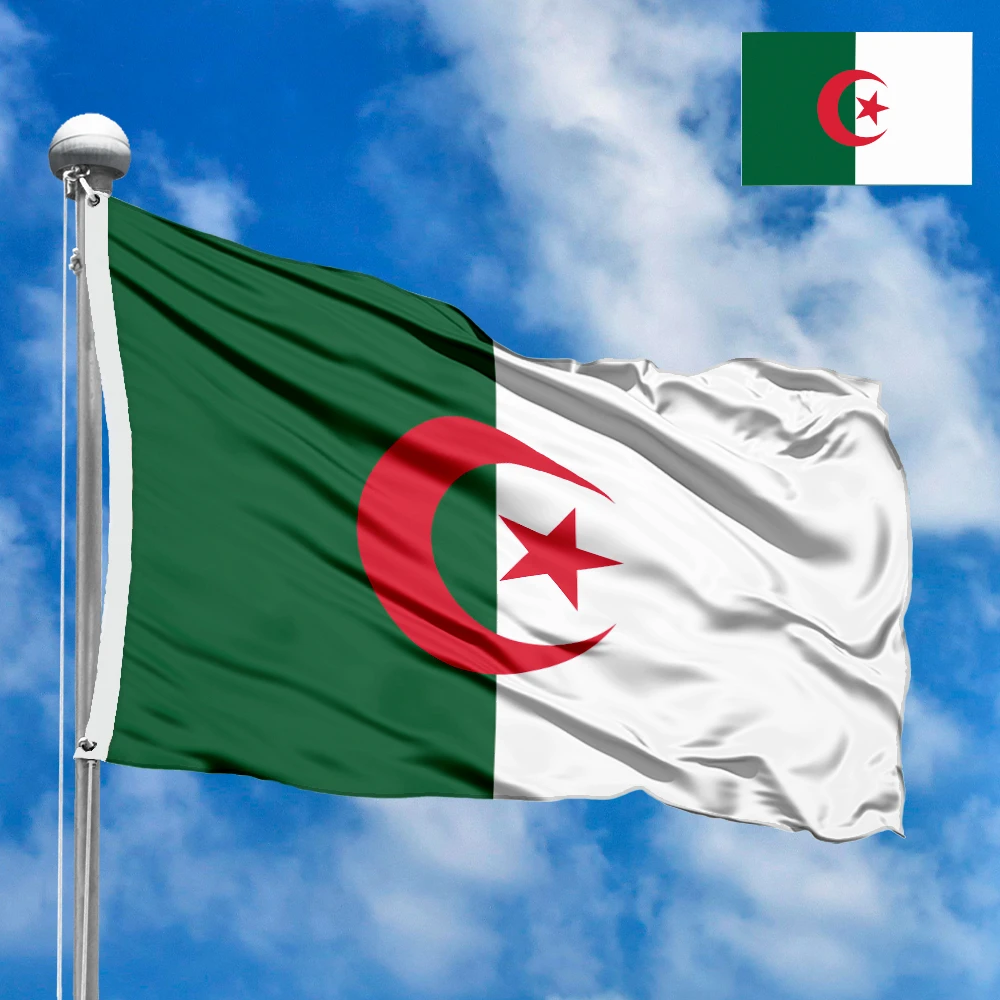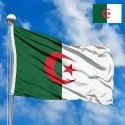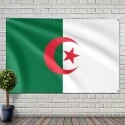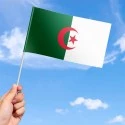Flag of Algeria
- Flag Type: State
- Proportions (official): 2:3
- Official name: People's Democratic Republic of Algeria
- Local name: الجمهورية الجزائرية الديمقراطية الشعبية
- Sovereignty (year): YES (1962)
- Member of Organizations: UN, African Union, League of Arab States, Organization of Islamic Cooperation
- Country code, territory: DZ, DZA, 012
- Capital: Algiers
- Large cities: Oran, Constantine, Annaba
- Population: ~46,600,000 (2024, UN)
- Religions: Islam (Sunni) ~99%
- Area (km²): 2 381 741
- Highest point: Mount Tahat (3,003 m)
- Lowest point: Chott Melrhir (-40 m)
- Currency: Algerian dinar (DZD, د.ج)
- Languages: Arabic, Berber
- Dialing code: +213
- National domain: .dz
Flag Information
General information
Demography and Culture
Economy and communications
- All Flags
- Flags of Countries by Continent
-
Flags of Organizations
- Flags of UN countries
- Flags of the European Union countries
- Flags of NATO countries
- Flags of the countries of the Organization of Islamic Cooperation
- Flags of the countries of the Organization of American States
- Flags of the Arab League countries
- Flags of the African Union countries
- Flags of the countries of the Union of South American Nations
- Flags of the Commonwealth of Nations
- Flags of the countries of the Secretariat of the Pacific Community
- Flags of the Nordic Council countries
- Flags of the Caribbean Community
- Flags of the countries of the Association of Southeast Asian Nations
- Flags of the East African Community
- Flags of the countries of the Organization of Turkic States
- LGBT Community Flags
- Historical Flags
- Ethnic Flags
- Flags of the USA (states)
Description
The national flag of Algeria is a powerful and resonant symbol, embodying the nation's arduous struggle for independence, its rich Arab-Berber heritage, and its deep-rooted Islamic identity. More than just a piece of cloth, it is a testament to the resilience, courage, and unwavering spirit of the Algerian people who fought for over a century against colonial rule. Adopted on July 3, 1962, the very day Algeria gained full independence from France, the flag serves as a vivid reminder of the sacrifices made and the profound aspirations that forged the modern Algerian state. Its design, steeped in historical significance and national pride, tells a compelling story of liberation, unity, and the enduring connection to its cultural and religious foundations.
Design and Symbolism: A Banner of Independence and Identity
The flag of Algeria features a distinctive and instantly recognizable design: two vertical bands of equal width, green on the hoist side and white on the fly side, with a central red star and crescent. Each color and element within this design carries profound symbolic weight, reflecting the core principles, historical struggles, and ideological underpinnings that have shaped the nation:
-
The White Band: Purity, Peace, and Sacrifice. The white vertical band on the fly side (right side when viewed from the front) is a dominant and deeply significant element of the Algerian flag. It primarily symbolizes purity and peace, reflecting the aspirations of the Algerian people for a harmonious and prosperous future free from conflict. More profoundly, it also represents the sacrifices of the martyrs who fell during the arduous struggle for independence. The white evokes a sense of spiritual purity and the unwavering belief in a just cause, a cause for which countless lives were given. It speaks to the integrity and moral strength of the nation.
-
The Green Band: Hope, Prosperity, and Islam. The green vertical band on the hoist side (left side when viewed from the front) provides a striking contrast to the white and holds equally significant meaning. It primarily represents hope and prosperity, symbolizing the fertile lands of Algeria and the promise of a bountiful future for its people. Crucially, the green is also a traditional and powerful color in Islam, signifying the faith that is deeply woven into the fabric of Algerian society and culture. It evokes the spiritual guidance and moral principles that underpin the nation's identity, highlighting the strong connection between the Algerian people and their Islamic heritage. This color reflects growth, vitality, and the natural beauty of the country.
-
The Central Red Star and Crescent: Islam, Sovereignty, and Revolution. The red central emblem, consisting of a five-pointed star and a crescent, is the most iconic and ideologically charged component of the Algerian flag. These symbols are universally recognized emblems of Islam, signifying the nation's strong religious identity. However, in the context of the Algerian flag, they carry additional, profound meanings:
-
The Red Color: The Blood of Martyrs and Revolutionary Spirit. The red color of the star and crescent is highly significant. It explicitly symbolizes the blood shed by the martyrs during the Algerian War of Independence (1954-1962). This vibrant red serves as a poignant reminder of the immense human cost of freedom and the revolutionary fervor that ultimately led to the nation's sovereignty. It honors the ultimate sacrifice made by those who fought tirelessly against colonial oppression, ensuring their memory lives on in the very fabric of the flag.
-
The Crescent: Progress, Light, and Islamic Faith. The red crescent is a traditional symbol in Islam, often associated with progress and new beginnings. On the Algerian flag, it represents the Islamic faith that guides the nation, symbolizing the light and guidance of the religion. It also signifies progress and the nation's continuous forward movement towards development and a brighter future. The tips of the crescent on the Algerian flag point towards each other, a specific detail that is sometimes interpreted as a symbol of unity.
-
The Five-Pointed Star: The Five Pillars of Islam and National Unity. The red five-pointed star, placed within the crescent, is another prominent Islamic symbol. It explicitly represents the Five Pillars of Islam (Shahada, Salat, Zakat, Sawm, Hajj), which are fundamental tenets of the faith. Beyond its religious connotation, the star also symbolizes light, unity, and hope for the Algerian nation. Its five points can also be seen as representing the unity of the five historical regions of Algeria or the five principles guiding the nation.
-
Collectively, the central emblem of the Algerian flag serves as a powerful icon of the nation's deep Islamic roots, its hard-won sovereignty, and the revolutionary spirit that defined its path to independence. The harmonious blend of green, white, and red in the flag creates a visually striking and emotionally resonant symbol that encapsulates the identity and aspirations of the Algerian people.
Dimensions and Proportions: A Standardized Representation of National Identity
The official dimensions and proportions of the Flag of Algeria are meticulously defined to ensure its consistent and dignified appearance across all forms of display. The flag adheres to a specific and widely recognized width-to-length ratio of 2:3. This precise ratio is a common standard for national flags globally, providing a balanced and aesthetically pleasing rectangular shape. The 2:3 proportion is favored for its versatility, allowing the flag to be easily scaled for various display purposes, from monumental installations to smaller, handheld flags, while maintaining its visual integrity and symbolic clarity.
The internal divisions of the flag, particularly the vertical bands and the central emblem, also follow precise proportions to ensure visual balance and emphasis on its symbolic elements:
-
The two vertical bands (green and white) are of equal width. This means each band occupies one-half (1/2) of the total length of the flag. This equality emphasizes the balance between the nation's Islamic identity and aspirations for hope and prosperity (green) and its purity, peace, and the sacrifices for independence (white), suggesting that both aspects are equally foundational to the Algerian nation.
-
The central emblem, comprising the red star and crescent, is centrally placed and scaled to be clearly visible and prominent against the two contrasting background colors. The crescent and star are positioned to straddle the division line between the green and white bands, ensuring that both colors contribute to their visual prominence. While specific dimensions for the emblem itself are not always explicitly stated in general descriptions, its size and positioning are crucial for its symbolic impact. It is typically designed to fit proportionally within the central axis of the flag, ensuring it does not appear too small or too large relative to the overall flag dimensions. The diameter of the imaginary circle within which the crescent and star are inscribed is usually defined in official specifications to ensure uniformity, with the crescent typically encompassing the star.
This detailed proportional design is crucial for upholding the flag's dignity and ensuring its accurate representation as a proud national emblem. The 2:3 ratio and the precise divisional proportions of the green and white elements, along with the centrally placed red star and crescent, ensure that whether the flag flies majestically over government buildings, is displayed during international diplomatic events, unfurled at sporting competitions, or celebrated in national festivities, it consistently projects a strong, unified, and harmoniously balanced image. This adherence to precise dimensions is vital for conveying its message of faith, peace, sacrifice, and national unity to both its citizens and the world. The careful balance in design reflects the aspiration for a balanced and just society.
History and Evolution: A Flag Born of Unwavering Resistance
The history of Algeria's national flag is inextricably linked to the nation's prolonged and often brutal struggle for independence from French colonial rule. Its adoption on a momentous day underscores its direct connection to the triumph of the Algerian Revolution and the birth of the modern Algerian state.
-
French Colonial Rule and Early Resistance (1830-Early 20th Century): Algeria was colonized by France in 1830, leading to a brutal and prolonged occupation marked by widespread resistance. For over a century, the Algerian people lived under foreign domination, with their culture, language, and religion suppressed. During this period, no official Algerian national flag existed; the French Tricolour was the governing banner. However, various symbols of resistance emerged, often incorporating elements like the star and crescent, which were already deeply ingrained in Algerian Islamic culture.
-
Emergence of Nationalist Movements and Precursors to the Flag (1920s-1950s): In the early 20th century, as nationalist sentiments grew, various political and liberation movements began to form. The North African Star (Étoile Nord-Africaine - ENA), founded in 1926 by Messali Hadj, is often credited with using a flag that closely resembled the current Algerian national flag. This early flag featured green and white stripes with a red star and crescent, symbolizing the Arab-Islamic identity of Algeria and the aspiration for independence. This design was later adopted by the Movement for the Triumph of Democratic Liberties (MTLD), another nationalist party led by Messali Hadj. This continuity indicates that the core elements of the flag were already established within the nationalist movement decades before independence.
-
The Algerian War of Independence (1954-1962): The decisive phase of Algeria's struggle for independence began on November 1, 1954, with the launch of an armed uprising by the National Liberation Front (Front de Libération Nationale - FLN). The FLN adopted the green, white, red, star, and crescent design as its official banner, representing the revolutionary cause. This flag became the de facto symbol of the Algerian resistance, flown in secret and bravely displayed by the combatants of the Army of National Liberation (ALN). It was under this flag that countless sacrifices were made, and the dream of an independent Algeria was kept alive.
-
Official Adoption on Independence Day (July 3, 1962): After nearly eight years of brutal warfare, the Evian Accords were signed in March 1962, paving the way for Algeria's independence. Following a referendum, Algeria officially declared its full independence on July 5, 1962. However, the flag was formally adopted and first raised as the national flag on July 3, 1962, just days before the official declaration, as the provisional government took control. This immediate adoption of the FLN's banner as the national flag underscored its direct link to the revolutionary triumph and the establishment of a new, sovereign Algerian state.
-
Post-Independence: A Consistent Symbol: Since 1962, the design of the Algerian flag has remained unchanged. It has served as a consistent symbol of national unity, sovereignty, and the enduring legacy of the revolution, even as the country navigated various political and social challenges. The flag’s stability in design reflects the strong foundational principles established during the independence struggle, principles that continue to resonate deeply with the Algerian people.
The Algerian flag, therefore, is not merely a national emblem but a living testament to a heroic past, deeply rooted in religious identity and forged through the fires of liberation. Its history is a testament to the nation's profound and often challenging evolution, always pointing back to the unwavering spirit of its people.
Regional Context and North African Identity: A Beacon of Islamic and Anti-Colonial Heritage
The flag of Algeria holds a prominent and deeply symbolic position within the vexillological landscape of North Africa and the broader Arab world, reflecting the region's shared history of Islamic identity, anti-colonial struggles, and cultural interconnectedness. While distinct in its specific design, the Algerian flag shares significant thematic resonance with many of its neighbors, particularly those that emerged from protracted conflicts against European colonial powers.
-
Shared Islamic Symbolism: The most striking commonality is the prominent use of the star and crescent, along with the colors green and red. These are universal symbols of Islam, deeply ingrained in the cultural and religious fabric of North Africa and the Middle East. Flags of countries like Tunisia, Libya, Mauritania, and Turkey (though not in North Africa, a significant regional influence) all feature the star and crescent. This shared symbolism highlights Algeria's strong Islamic identity and its connection to the wider Ummah (global Muslim community), a foundational element of its national character. The green represents Islam and hope, while the red signifies sacrifice, echoing similar uses in many regional flags.
-
Legacy of Anti-Colonial Struggle: Algeria's flag is primarily a banner born of an intense and bloody anti-colonial war against France, one of the most brutal decolonization conflicts of the 20th century. This history resonates strongly with neighbors like Tunisia and Morocco, who also gained independence from French protectorates, albeit through different means. The red in the Algerian flag, explicitly symbolizing the blood of martyrs, is a powerful reminder of this shared legacy of resistance and the high cost of freedom, a narrative that binds many nations in the region. It stands as a beacon for other nations that sought or are seeking self-determination.
-
Arab and Berber Identity: The flag's design, while primarily referencing Islamic faith and revolutionary struggle, implicitly acknowledges the dual Arab-Berber heritage that defines Algeria. While not explicitly represented by separate colors or symbols, the flag's overall resonance speaks to a unified Algerian identity forged through these diverse cultural strands. In the broader North African context, this cultural blend is a common feature, making Algeria’s flag a representation of this unique regional identity.
-
A Symbol of Pan-Arabism (historical context): In the mid-20th century, the era of decolonization coincided with the rise of Pan-Arabism. While Algeria's flag is distinct from the Pan-Arab colors (black, white, green, and red in horizontal stripes), its use of green, white, and red and its strong anti-colonial stance resonated with broader Arab nationalist movements. Its adoption symbolized the triumph of Arab and Muslim identity over foreign domination, aligning it with the aspirations of many newly independent Arab states.
-
Distinctiveness within Similarity: While sharing common elements, the Algerian flag maintains its distinctiveness. Its vertical bicolor layout (green and white) differentiates it from many regional flags that use horizontal stripes (e.g., Egypt, Iraq, Syria) or a single color field (e.g., Libya's previous flag). The specific orientation of the crescent (tips pointing towards each other) is also a unique detail. This balance of shared heritage and unique national expression makes the Algerian flag a powerful emblem within its regional context, signaling both common bonds and an independent spirit.
In essence, the flag of Algeria stands as a potent symbol within North Africa and the Arab world, embodying a shared history of Islamic faith, hard-won liberation, and the complex journey of nation-building. Its design tells a specific Algerian story, yet it resonates with broader regional themes of resilience, cultural pride, and the enduring pursuit of self-determination.
Interesting Facts About The Flag of Algeria:
-
Independence Day Adoption: The flag was officially adopted on July 3, 1962, just two days before Algeria officially declared its full independence from France on July 5, 1962. This makes it a direct symbol of the nation's liberation.
-
FLN Origins: The design of the national flag is directly derived from the flag of the National Liberation Front (FLN), the primary revolutionary movement that led Algeria to independence. It was the banner under which they fought the war.
-
Historical Precursors: A very similar flag, featuring green and white stripes with a red star and crescent, was used by Algerian nationalist movements like the North African Star (ENA) and the Movement for the Triumph of Democratic Liberties (MTLD) decades before independence, dating back to the 1920s. This shows a long historical continuity for the design.
-
Meaning of Colors:
-
White: Symbolizes purity, peace, and the sacrifices of the martyrs who died for independence.
-
Green: Represents hope, prosperity, and the Islamic faith, which is central to Algerian identity.
-
Red (star and crescent): Symbolizes the blood shed by the martyrs during the war of independence.
-
-
Islamic Symbols: The red star and crescent are universal symbols of Islam. The five points of the star often represent the Five Pillars of Islam. The crescent typically signifies progress and new beginnings.
-
Crescent Orientation: On the Algerian flag, the tips of the red crescent point towards each other. This specific orientation is sometimes interpreted as a symbol of unity or a welcoming gesture, distinguishing it from other flags where the crescent tips might point away.
-
Unchanged Since Independence: Despite significant political changes and challenges over the decades, the design of the Algerian flag has remained unchanged since its adoption in 1962, solidifying its status as an enduring national emblem.
-
Rare Vertical Bicolor with Central Emblem: While many flags use vertical bicolors, it's less common for them to feature a central emblem that straddles the two colors as prominently as the Algerian flag, making its design distinctive.
-
Source of National Pride: For Algerians, the flag is a profound source of national pride, representing not only their hard-won independence but also their deep cultural and religious identity forged through centuries of history.
-
High Proportions of Red: The total amount of red in the flag (within the star and crescent) is relatively small compared to the green and white, yet its symbolic weight is immense, representing the ultimate sacrifice for freedom.
Significance for the Inhabitants: A Banner of Hard-Won Freedom and Enduring Identity
For the people of Algeria, their national flag is far more than a mere national emblem; it is a profound and deeply resonant symbol that embodies their nation's tumultuous history, the immense sacrifices made for independence, and their collective aspirations for peace, prosperity, and the preservation of their unique identity. It serves as a constant visual reminder of their heritage as Algerians and the core principles that continue to shape their national consciousness.
The white band speaks directly to the hearts of Algerians, symbolizing purity, peace, and, crucially, the sacrifices of the martyrs who gave their lives for the nation's freedom. For generations who lived through the brutal war of independence or whose families bore witness to it, this white evokes a deep sense of reverence, gratitude, and remembrance for those who laid the foundation for a sovereign Algeria. It instills a sense of national pride in their resilience and unwavering spirit, reminding them that their independence was not given but fiercely earned. This color unites them in a shared memory of suffering and triumph.
The green band represents hope, prosperity, and the vital role of Islam in Algerian society. For Algerians, this green band signifies the promise of a bountiful future, reflecting their aspirations for economic growth and a flourishing nation. More importantly, it embodies their profound connection to their Islamic faith, which serves as a cornerstone of their cultural and moral values. It fosters a sense of unity and pride in their religious heritage, reminding them of their spiritual roots and their place within the broader Muslim world. This color reinforces their identity as a people guided by strong spiritual principles.
The central red star and crescent hold particular significance for the nation's people. The red color profoundly symbolizes the blood shed by countless martyrs during the liberation struggle. This powerful visual element evokes deep emotional resonance, honoring the ultimate sacrifice made to achieve freedom. For every Algerian, it is a constant reminder of the immense price paid for their independence and the bravery of those who fought against oppression. The crescent and star, universal symbols of Islam, reinforce their strong religious identity, representing the five pillars of their faith and their unwavering commitment to Islamic values. These symbols provide a sense of spiritual belonging and a connection to a rich cultural legacy.
When the flag is proudly displayed—during national holidays like Independence Day, at schools, on government buildings, during sporting events, or in private homes—it invariably ignites a profound sense of patriotism, unity, and shared destiny among the Algerian people. Despite various political and social challenges throughout its history, the flag has remained an unwavering symbol, representing the enduring spirit of the nation. For the inhabitants, the flag is a living testament to their resilience, their ability to overcome immense challenges, and their collective aspiration for a future built on peace, prosperity, and national cohesion. It is a cherished emblem that unites them, reminding them of who they are and what they stand for as a free, sovereign, and deeply rooted nation.
In the demonstration images, full-size flags are shown with proportions of 2:3, and hand-held flags with proportions of 1:2.
Donation
Download
Completely free for commercial and non-commercial use (public domain).
You can freely use them in your news magazines, websites, software, mobile applications.
We appreciate a backlink to https://flagssite.com
Raster files - Flag of Algeria (PNG, JPG)
 Waving flag
Waving flag
- PNG format (transparent background), 72dpi, dimensions in Pixels (px), aspect ratio 3:4.
- 15х20 px
- 30х40 px
- 60х80 px
- 120x160 px
- 240x320 px
 Sizes:
Sizes:
"v15" - image size (by height); if necessary, replace with available: v15, v30, v60, v120, v240.
!!! For resizing, use the Latin (eng) keyboard layout.
<img src="https://flagssite.com/flags/v15/20401.png" alt="Flag of Algeria">
 Round flag
Round flag
- PNG format (transparent background), 72dpi, dimensions in Pixels (px), aspect ratio 1:1.
"d15" - image size (diameter); if necessary, replace with available: d15, d30, d60, d120, d240.
!!! For resizing, use the Latin (eng) keyboard layout.
<img src="https://flagssite.com/flags/d15/20401.png" alt="Flag of Algeria">
 Rectangular flag 2:3
Rectangular flag 2:3
- JPG format, 72dpi, dimensions in Pixels (px), aspect ratio 2:3.
"h30" - image size (by height); if necessary, replace with available: h15, h30, h60, h120, h240, h360, h480.
!!! For resizing, use the Latin (eng) keyboard layout.
<img src="https://flagssite.com/flags/h30/20401.jpg" alt="Flag of Algeria">






 Sizes:
Sizes:
 Sizes:
Sizes: